Abstract
Collaborative workplaces are increasingly used in production systems. The possibility of direct collaboration between robots and humans brings many advantages, as it allows the simultaneous use of human and robotic strengths. However, collaboration between a collaborative robot and a human raises concerns about the safety of the interaction, the impact of the robot on human health, human efficiency, etc. Additionally, research is unexplored in the field of the collaborative robot’s audio-visual effects on the worker’s efficiency. Our study results contribute to the field of studying collaborative robots’ audio-visual effects on the worker’s behavior. In this research, we analyze the effect of the changing motion parameters of the collaborative robot (speed and acceleration) on the efficiency of the worker and, consequently, on the production process. Based on the experimental results, we were able to confirm the impact of robot speed and acceleration on the worker’s efficiency in terms of assembly time. We also concluded that the sound level and presence of a visual barrier between the worker and robot by themselves have no effect on the worker’s efficiency. The experimental part of the paper clearly identifies the impact of visualization on work efficiency. According to the results, the robot’s audio-visual effects play a key role in achieving high efficiency and, consequently, justifying the implementation of a collaborative workplace.
1. Introduction
Collaborative Workplaces (CWs) are being implemented increasingly in production systems. The ability to collaborate directly between robots and humans brings many advantages, as it allows the simultaneous use of human and robotic strengths. CWs between humans and robots are a new production concept that ensures high efficiency and flexibility [1], while the importance of humans and the impact of robots on them is unknown [2]. Past research proves that the effectiveness of a CW is affected by various production parameters [3], which need to be studied in detail in order for the CW to have a positive impact on the production, social, and environmental characteristics of the production system [4,5]. Previous research has focused mainly on the capacities of production systems and the efficiency of collaborative robots, while limiting itself to a detailed study of human capabilities. As stated in previous research, the balance between collaborative robots and workers is crucial for an optimized production system. The problem of the available CW capacities requires adequate planning [6], which allows the use of various known methods for allocating the available capacities. Here, the importance of the adequate design of a CW is crucial to achieving optimal utilization of the entities in the production process [7], where the research areas of ergonomics and production capacities and the balance between them are intertwined. When not integrated properly, a CW can represent new bottlenecks where unplanned micro-downtime presents wasted time for both the worker and the robot, and, consequently, for the entire production system [8]. According to the research, optimizing the proper introduction of a CW into new or existing production processes is crucial for effective human-centric collaborative work environments [9], where authors confirm that robot motion parameters affect workers operation time. The use of advanced simulation tools [10] and augmented reality methods [11] enables effective communication and information transfer between workers and robots [12]. Collaboration between a collaborative robot (CR) and a human also raises concern about the safety of the interaction, the impact of the robot on human health, human efficiency, etc., even though safety standards already exist.
The results of previous research [9] show the importance of investigating the impact of the acoustic and visual effects of a CR on the worker. In this case, the research questions concern the importance of proper CR setting parameters where the CW is optimally utilized and the worker is exposed to an even and balanced workload from both a physical and mental perspective. The importance of studying the effects of sound on the efficiency of the workplace was shown by previous research [13], according to which high sound levels can have negative and long-lasting effects on the worker [14]. Researchers are therefore already investigating the impact of CR parameters, types of implementations, and the impact of environmental factors on humans. In past research, we have found studies on the effects of robot parameters on workers’ workload [15], their mental health [16], workers’ efficiency [9], etc. When the motion parameters of the CR change [9], the visual impact of the robot also changes, which can affect the mutual cooperation between the worker and the robot [17]. Research in the field of the impact of audio-video characteristics of a CR [18,19], emphasizes the importance of studying this area from the workplace adequacy point of view, but it does not mention the importance of the direct acoustic impact and visual motion of the CR under different operating parameters, which play a key role in the goal of optimal production capacity utilization.
The findings show that the field of Human–Robot Collaboration (HRC) is extremely broad and still relatively unexplored in terms of the mutual relationship between CRs and humans, and vice versa. Throughout the findings of the preliminary experiments and performed studies [9], we have observed changes in human well-being, their behavior, and work performance in various collaborative scenarios. These observations have led us to expand our research and investigate the impact of factors such as the presence of sound, visual contact between the human and the CR, and CR parameters on worker efficiency and well-being, as we believe they play an important role in designing an efficient and healthy HRC. In the present research, we aim to show how the sound level of a CR at different speeds and accelerations affects the worker’s feelings, assembly time, and workplace efficiency, as shown in Figure 1.
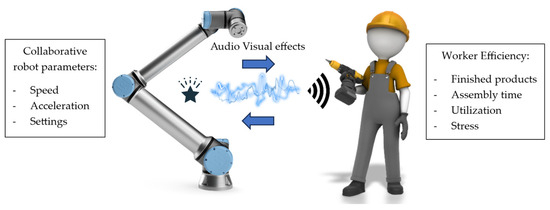
Figure 1.
Research problem.
In the present research work, we present the method of descriptive and repeated measures, the ANOVA (RM ANOVA) statistical method, which analyzes in detail the effect of the CR changing parameters (speed and acceleration) on the efficiency of the worker and, consequently, the production process. Therefore, our study provides answers to the following research questions:
- RQ1: Does changing the CR motion parameters affect CW efficiency?
- RQ2: Does CR sound and visual contact between the worker and the CR affect CW efficiency?
- RQ3: Which type of scenario (design of CW) is the most suitable for the workers?
The remainder of this paper is structured as follows: in the second chapter, we describe the CW and the collaborative operation of our experiment. Next, we present the experiment design and selected statistical methods necessary to evaluate the obtained results. The Results chapter focuses on two aspects of the results, using descriptive statistics and inferential statistical methods. This is followed by the Discussion chapter, where we discuss and summarize the obtained results and findings. Some study limitations, practical implications, and suggestions for future research are given in the final chapter, the Conclusion.
2. Methods
2.1. Collaborative Workplace Description
The experiment was conducted in a laboratory environment, for which a CW was adapted. The CW is shown in Figure 2, and it consisted essentially of a CR UR3e ①, a collaborative gripper Robotiq 2F-85 ②, a worktable ③, a switch with signal lights (green and red) ④, a button ⑤, semi-finished products 1 ⑥, semi-finished products 2 ⑦, a buffer of semi-finished products 2 ⑧, and a buffer of finished products ⑨.
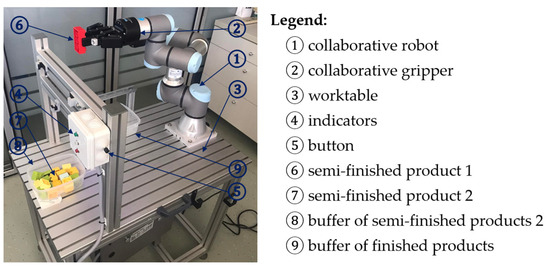
Figure 2.
Layout of CW in the experiment.
2.2. Description of the Collaborative Assembly Operation
To conduct our experiment, we designed a collaborative assembly application in which a human and a CR worked together to assemble a finished product. The finished product is shown in Figure 3 and consisted of two Lego Duplo 2 × 2 bricks (semi-finished products 2 ⑦) and one Lego Duplo 4 × 2 brick (semi-finished product 1 ⑥).
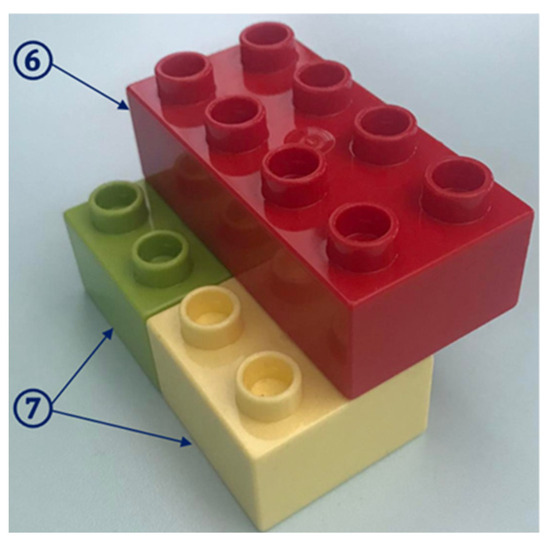
Figure 3.
Assembled finished product.
At the beginning of the assembly operation, the CR ① picked up the semi-finished product 1 ⑥ and moved it to the assembly point. Meanwhile, before the CR ① brought the semi-finished product 1 ⑥ to the assembly point, the human prepared two semi-finished products 2 ⑦, one green and one yellow. The color of the semi-finished products 2 ⑦ was important, as a sequence of attachment was determined. The human had to grasp the green brick with the left hand and the yellow brick with the right hand. The green brick had to be attached to the lower part of the semi-finished product 1 ⑥, and the yellow brick to the upper part of the semi-finished product 1 ⑥.
When the CR ① arrived at the assembly point, the green signal light on the indicator ④ turned on, indicating that the human could attach the semi-finished products 2 ⑦. After the assembly was completed, the human confirmed the continuation of the process by pressing the button ⑤. The green light on indicator ④ turned off, and the red signal light turned on. The red signal light prohibited the human from reaching into the CR’s workspace and their shared assembly area.
The CR ① carried the finished product to the buffer of finished products ⑨ and repeated the process. The assembly operation continued until the human and the CR had assembled a certain number of finished products.
2.3. Experiment Design
The aim of the experiment was to investigate how varying the motion parameters of the CR, their associated sound levels, and the visibility of CR movements impact the human in CW. To investigate these aspects, we divided the experiment into two main scenarios.
The first scenario consisted of a basic workstation, as shown in Figure 2. In the second experiment scenario, we added a barrier to the CW, as shown in Figure 4. The barrier prevented visual contact between the human and the CR and made it impossible to monitor the CR’s movement and speed. By changing the CW layout and splitting the experiment into two scenarios, we aimed to investigate how the ability or inability to monitor the movements of the CR affects the worker’s efficiency. In our study, worker efficiency was measured as the time needed by a worker to conduct the previously described collaborative assembly operation.
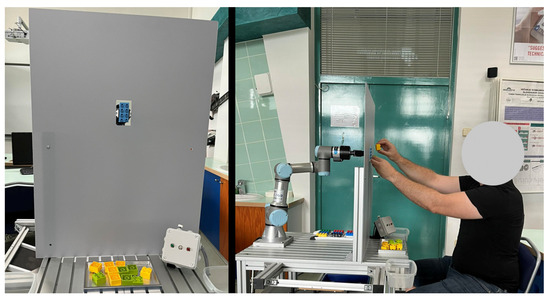
Figure 4.
CW with barrier to prevent visual and physical contact between the CR and a human.
These two scenarios formed the basis of the experiment. However, to study the impact of motion parameters and associated sound levels further, the experiment had to be subdivided. To study these impacts, each scenario was divided into nine smaller subsets. The subsets consisted of nine different combinations of CR motion parameters (speed and acceleration) and CR sound levels. The combinations we defined included three levels of CR motion parameters (60%, 80%, and 100%) and three levels of prerecorded sounds. Firstly, Table 1 presents the CR motion parameter levels in terms of speed and acceleration values.

Table 1.
Collaborative robot speed and acceleration at defined motion parameter levels.
In order to study the effects of different sound levels on worker efficiency carefully, it was necessary to simulate different sounds throughout the experiment. To achieve this, the sounds of CR movements at previously defined motion parameters were recorded before the start of the experiment. To prevent environmental distractions, the participants had to wear noise-canceling headphones (Marshall Major IV) for the whole duration of the experiment. The prerecorded sounds were played through the headphones and were changed based on the sequence of combinations shown later. During the experiment, the participants were not informed of any changes in the CR’s motion parameters or the sounds they heard, nor whether the sound they heard corresponded to the actual movements of the CR. For the purposes of the experiment and to facilitate the interpretation of the results, we described sound levels with the same terms as the CR motion parameters. This approach allowed easier execution of the experiment and easier interpretation of the results. However, we measured the sounds of the CR at different motion parameters’ levels using a sound measuring device, a Voltcraft SL-100 (Conrad, Hirschau, Germany), measuring range from 30 dB to 130 dB. Table 2 shows the values of the average sound pressure level (LAeq), the maximum level (Max. level), and the peak sound pressure level (LCpeak) for each motion parameter level.

Table 2.
Definition of sound levels at different motion parameters.
The order of the combinations of CR motion parameters and sound levels is shown in Table 3, and they were chosen randomly in order to prevent the appearance of learning effects or fatigue in participants.

Table 3.
Combinations of collaborative robot motion parameters and sound levels.
Fourteen people took part in the experiment, including seven women and seven men, with an average age of 38 years. Prior to the experiment, the participants were only familiarized with the assembly procedure, and they were not informed about the different combinations of motion parameters and sound levels of the CR. To ensure the validity of the experiment and to obtain as realistic results as possible, the research aim was not disclosed to them. The participants completed the first scenario (nine factor combinations at the CW without the barrier) and then the second scenario of the experiment (nine factor combinations at the CW separated by the barrier). Each subset ended after 30 finished products had been assembled. The participants’ assembly times within each individual combination and their responses to the research questions constitute our output data for the experiment.
2.4. Statistical Methods
After the data were collected, a suitable statistical approach had to be determined. One of the most common methods for determining whether two populations have the same mean or whether two groups within a population have the same mean is the t-test. However, when the number of groups increases, analysis of variance (ANOVA) is used instead. ANOVA [20] is a procedure that helps isolate the sources of variability and determine the impact of the observed independent variable on the dependent variable. This procedure assumes that the number of participants is a multiple of the total number of levels for each factor (also called treatment levels) [21]. This means that, for a three-factor experiment (e.g., two factors at three levels and one factor at two levels) and assuming at least two participants per group, the required number of participants is thirty-six. However, experimental studies often collect responses from the same subjects’ multiple times under different conditions (treatment levels) or over a period of time. The use of the standard method ANOVA is inappropriate in such cases, as it overlooks intra-subject dependencies, and the repeated measures method ANOVA (RM ANOVA) is more appropriate. The advantage of this method is that it requires fewer participants since the same participant is measured under all conditions (treatment levels) of the study. Another advantage is that individual participants serve as their own controls (i.e., they provide their own comparisons), and each participant’s performance can be compared across all treatment levels [22]. However, the major drawback of this method is the so-called order effect, which refers to changes in participants’ performance due to learning effects or fatigue. The repeated measures method (ANOVA) also requires certain assumptions to be met. If these assumptions are violated, studies are subject to potential statistical errors that can lead to inaccurate conclusions [23]. After the main analysis is carried out and the significant main effects are found, post-hoc tests in the form of pairwise comparisons have to be conducted in order to find where these significant differences lie among the different factor levels. Pairwise comparisons compare all possible pairs of means, although, in the case of repeated measures, the measures are correlated, and it is essential that some adjustment is carried out. A commonly used method for the adjustment of pairwise comparisons is the Bonferroni adjustment. It controls the Type I error rate across multiple sets of comparisons, which means that the probability of observing statistically significant results by chance is reduced [24].
A three-way repeated-measures ANOVA was performed to examine the effects of the barrier, CR motion parameters, and CR sound levels. To perform this analysis successfully, five key assumptions had to be met [23]:
- There is a single dependent variable measured on a continuous scale.
- There are three within-subject factors, where each factor has at least two categorical levels.
- There are no significant outliers in any cell of the design.
- Approximate normal distribution of the dependent variable across all design cells.
- Equal variance across the levels of the independent variables (also referred to as the assumption of sphericity).
Initial tests of outliers, normality, and sphericity were carried out with the use of the IBM SPSS statistics software. After it was confirmed that the assumptions were met, the main analysis was carried out—a three-way repeated measures ANOVA. Pairwise comparisons were carried out for statistically significant factors and interactions between factors. In the context of statistical analysis, interaction refers to a situation when two or more variables have a combined effect on another variable. In short, it represents an effect when variables are multiplied together [24].
3. Results
The Results section is divided into two subsections. In the Section 3.1, “Experiment results and descriptive statistics”, we present our general results and findings from the experiment using descriptive statistics and the use of tables and graphs. In the Section 3.2, “Experiment results and inferential statistical tests”, the descriptive results and findings were tested with the use of the three-way repeated measures ANOVA. Initially, the collected data were organized in a long format but were later transformed to a wide format to meet the requirements of the IBM SPSS statistics software to conduct a three-way repeated-measures ANOVA.
3.1. Experiment Results and Descriptive Statistics
The combinations in which participants within a specific scenario achieved the shortest average assembly time are shown in Table 4. To determine the preference of a specific factor (CR motion parameters or sound levels) within a combination, we used three symbols in the “Preference” tab to indicate the preferred factor. The symbol “>” signifies that a participant achieved the shortest average assembly time when the CR motion parameters were higher than the sound level; the symbol “=” means that the CR motion parameters and sound level were the same, which means that the prerecorded sound that was played through headphones matched the actual motion parameters of the CR; and the symbol “<” means that a participant achieved the shortest average assembly time when the prerecorded sound was higher than the CR motion parameters. The calculated average assembly time for each participant in each combination was based on 30 iterations within the specific combination.

Table 4.
Combinations where participants achieved the shortest assembly time.
The pie chart in Figure 5a shows the proportion of participants who achieved the shortest average assembly time in each combination of CR motion parameters and sound levels while working at the CW without the barrier. The pie chart in Figure 5b differs from the pie chart in Figure 5a only in that the results shown are from the second scenario, where participants worked at the CW with the barrier.
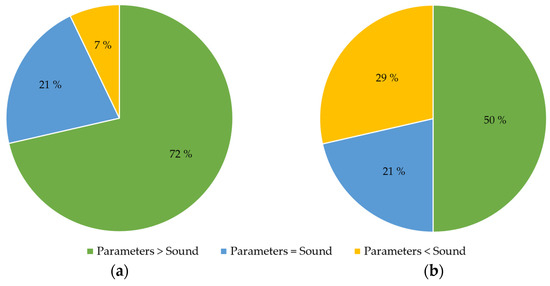
Figure 5.
Percentage display of the shortest average assembly times obtained in each combination of collaborative robot parameters and sound: (a) At CW without barrier; (b) At CW with barrier.
In the first scenario, where the participants worked together with the CR without the barrier, 72% of the participants achieved the shortest average assembly time when the CR motion parameters were higher than the sound level, 21% achieved it when the motion parameters were equal to the sound level, and 7% achieved it when the sound level was higher than the motion parameters. After the modification of the CW and the introduction of the barrier, the percentage of participants who achieved the shortest average assembly time with higher CR motion parameters and a lower sound level decreased to 50%. The percentage of participants who achieved the shortest average assembly time when motion parameters and sound levels were equal remained the same at 21%, while the percentage of participants who achieved the shortest assembly time at higher sound levels and lower CR motion parameters increased to 29%.
In the scenario without the barrier, a significant percentage of participants achieved the shortest average assembly time with the combination of higher CR motion parameters and a lower sound level. A closer look at Table 4 reveals that, out of the fourteen participants, eight of them achieved the shortest average assembly time with the highest defined motion parameters of the CR. Based on the results, we can assume that the motion parameters of the CR have an impact on the worker’s efficiency. This conclusion becomes even clearer when comparing the results of the first scenario (CW without barrier) with the results of the second scenario (CW with barrier).
In the second scenario, the percentage of participants with the shortest average assembly time decreased to 50% in the combination of higher motion parameters and a lower sound level. Compared with the first scenario, this represents a decrease of 22%. The decrease in the percentage of participants in the second scenario who achieved the shortest average assembly time at higher motion parameters and lower sound level, along with the increase in the percentage of participants who achieved the shortest time with higher sound level and lower CR motion parameters, indicates that sound might affect the worker to a certain degree, but further tests need to be performed to obtain a clear answer.
When comparing the results of the average assembly time of all participants, the average assembly time of the CW without the barrier was 2.86 s, and when the barrier was introduced, the time decreased to 2.74 s, indicating a 4.2% reduction in average assembly time. From our preliminary results, we can assume that the barrier also plays a certain role in a worker’s behavior. When a worker is unable to track the CR’s movement and relies less on visual cues, they might start to focus more intensively on the sound of the CR’s movements. Again, further statistical tests are needed to confirm this initial finding.
After obtaining the results of all the included combinations of CR motion parameters and prerecorded sound levels, we were additionally interested in finding out which of the two scenarios (with or without a barrier) was more suitable for the participants in terms of their comfort during the collaboration with the CR. Although the CR is designed for direct interaction with humans, we were interested to see which scenario was preferred.
During the experiment, after each completed combination, the participants had to answer a question on a four-level scale and assess their ability to perform the work under the current conditions. After the experiment, they also had to indicate which of the scenarios with the CR they thought was more suitable: the scenario without the barrier or the scenario with the barrier.
Out of the fourteen participants in the experiment, nine answered that the CW without the barrier was more suitable, while five participants preferred the CW with the barrier. Nine participants represent 64% of the total participants in the experiment, from which we can conclude that collaboration without the barrier was slightly preferable. The participants who preferred the collaboration without a barrier justified their decision with the possibility to observe the CR’s movement and awareness of its current position. Those who have chosen the collaboration with the barrier justified their decision mainly on the safety aspect and the feeling of security.
To support the result regarding the preferred scenario, we offered participants four possible responses to assess their comfort and ability to collaborate with the CR under the defined motion parameters and sound levels. After each completed combination, the participants chose an answer from a set of four options: “Impossible”, “Difficult”, “Appropriate”, and “Great”. In each experiment scenario, 126 responses were obtained (14 participants × 9 responses). The results are shown in Figure 6.
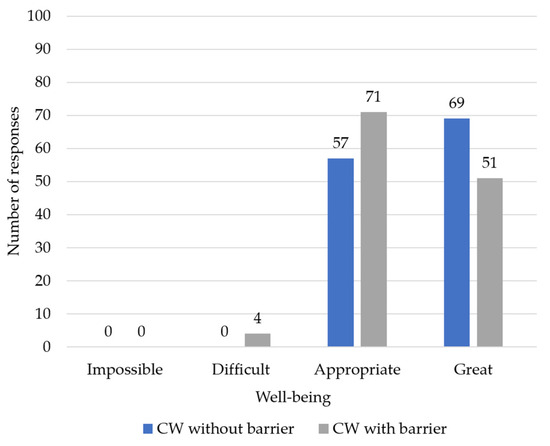
Figure 6.
Received responses about human well-being while working with a CR in each scenario.
In the scenario without a barrier, we received 69 responses for “Great” during collaboration, 57 responses for “Appropriate”, and no response for “Difficult” or “Impossible”. Comparing these with the responses from the scenario with the added barrier, the number of responses for “Great” decreased to fifty-one, the number of responses for “Appropriate” increased to seventy-one, and four responses for “Difficult” were obtained. Again, none of the participants chose the response “Impossible”.
When comparing the scenarios, we can see that there were 18 more responses for “Great” in the scenario without the barrier than in the scenario with the barrier. Also, in the scenario without the barrier, no response for “Difficult” was obtained, whereas in the scenario with the barrier, there were four such responses. Based on the results shown in Figure 6, in the scenario with the barrier, the participants’ well-being started to decrease compared with the scenario without a barrier, which confirms that working with the CR without the barrier might be more suitable for workers. As we have already indicated in the previous analysis, visualization might play an important role in the HRC. Nevertheless, the distribution of responses requires further statistical testing to confirm our assumption.
3.2. Experiment Results and Inferential Statistical Tests
The three-way RM ANOVA had to be carried out to confirm the previous findings. The first step was to check if all of the assumptions were met. The study design satisfied the first two assumptions inherently. The dependent variable, mean assembly time, was continuous, and there were three distinct factors: barrier (2 levels), CR motion parameter (3 levels), and CR sound level (3 levels). Box plots were utilized to verify the absence of significant outliers. Table 5 lists the order of experiment runs and the corresponding combinations of motion parameters, sound levels, and barrier use.

Table 5.
Order of experiments and their associated factor levels.
Then, Figure 7 was created with boxplots and the associated numbers for the experiment runs. The box plots provide a visual representation of the data distribution for different combinations of factors (and their levels) and confirm the absence of any outliers, as shown in Figure 7.
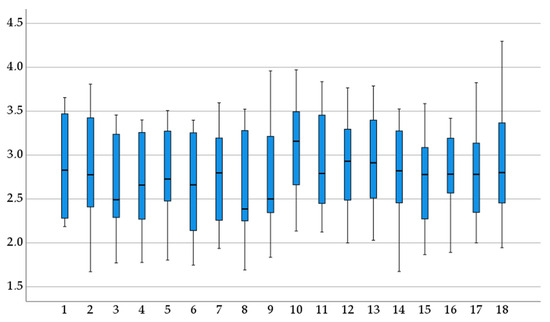
Figure 7.
Boxplots for each of the factor combinations.
The assumption of normality was assessed using Shapiro–Wilk’s test of normality [25], and it was found that the mean assembly time values were normally distributed across all combinations of motion parameters, sound levels, and the use of a barrier. The Shapiro–Wilks’s test was used due to its proven power of assessing normality when compared with the Anderson–Darling, Lilliefors, and Kolmogorov–Smirnov tests [26].
The final assumption, the assumption of sphericity (equality of variance across all independent variables), was tested for every experiment factor in the analysis and their interaction (marked as multiplication between two factors), using Mauchly’s test of sphericity [27]. Table 6 provides the approximate χ2 values, degrees of freedom (df) of the Mauchly’s test, significance value, and Greenhouse–Geisser correction for each factor and their interaction in the analysis:

Table 6.
Results for Mauchly’s test of sphericity.
Factors where the significance value of the Mauchly’s test is greater than 0.05 indicate that the assumption of sphericity has been met, and if the significance value is less than 0.05, this indicates a violation of this assumption, and a Greenhouse–Geisser correction should be used instead [28,29]. If the factor has only two levels (in our case, “barrier”), the assumption of sphericity is fulfilled automatically. Table 6 also shows that the assumption of sphericity was satisfied for sound level and the interaction terms barrier × motion parameter, barrier × sound level, and motion parameter × sound level, but violated for motion parameter and the three-way interaction barrier × motion parameter × sound level.
The results of the tests for within-subject effects had to be interpreted to deepen our understanding. These tests aim to determine if there are significant changes in outcomes within the same participants due to correlated measurements rather than measurements taken on different participants. The results in Table 7 show that, when the values in column Sig. are below 0.05, then that factor, or interaction between two or more factors, is statistically significant and has an impact on the mean assembly time. We can conclude that barrier (Sig. = 0.15) and sound level (Sig. = 0.07) by themselves have no effect on the mean assembly time, while the motion parameters by themselves have an effect on the mean assembly time (Sig. ≤ 0.001). Considering the different interactions, the results show that there is no statistically significant interaction effect between the use of a barrier and the CR motion parameters (Sig = 0.66), but there is a significant interaction effect between the use of a barrier and the sound levels (Sig. = 0.007). This result is consistent with the general findings and confirms that the combination of barrier and sound level has an effect on the mean assembly time. There is also a significant effect on the mean assembly time when there is an interaction between the motion parameters and the sound levels.

Table 7.
Results of within-subjects effects for the barrier, motion parameter, and sound level factors.
The initial within-subjects tests showed no statistically significant three-way interaction between the barrier, motion parameters, and sound levels. However, in the case of motion parameters, the Greenhouse–Geisser correction confirms that the motion parameters are a statistically significant factor in determining the mean assembly time.
Since statistically significant effects were found with the within-subjects tests, it was also necessary to determine which group means were different. Pairwise comparisons were made for motion parameters and for the interactions between barrier × sound level and motion parameters × sound level. A Bonferroni adjustment was applied. Table 8 shows the comparisons of mean assembly times when only the motion parameters were considered. The first column (I) shows the motion parameter level, and the second column (J) shows the motion parameter level it is compared with. In the third column, the difference between the means at those levels is calculated, and the significance of the result is provided. If the significance value is greater than 0.05, the difference is statistically insignificant. Significant results are bolded, and the 95% confidence interval is also provided.

Table 8.
Pairwise comparisons for the motion parameter factor at different levels.
The number of possible comparisons is duplicated since each pairwise comparison can be calculated in two ways. Only unique comparisons are provided in the results. The pairwise comparison of the motion parameter at 80% (column I) and the motion parameter at 60% (column J) shows no statistical significance, so only the comparison of the motion parameter at 100% (column I) is interpreted with the motion parameters at 60% and 80% (both in column J). When the motion parameter of the CR was set to 100% (column I), the mean assembly time was 0.137 (or 0.14) seconds lower compared with the motion parameter at 60% (column J) and 0.096 (or 0.1) seconds lower compared with the motion parameter at 80% (column J). This confirms that an increasing motion parameter leads to a lower mean assembly time and is also shown in Figure 8.
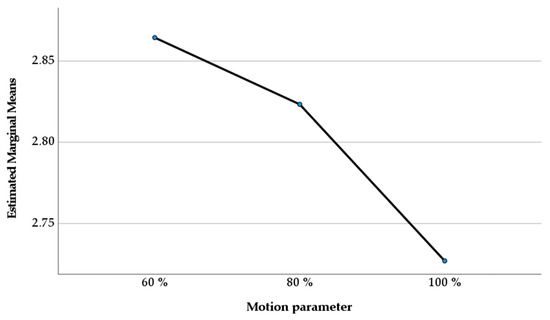
Figure 8.
The effect of speed on estimated marginal means of assembly time.
Next, a pairwise comparison of the interaction between motion parameters and sound levels was performed, and the results are shown in Table 9. There were two statistically significant combinations in this comparison. Interestingly, when the motion parameter of the CR was set to 60% (column motion parameter) and the sound level was set to 80 (column I), the mean assembly time increased by 0.227 (or 0.23) seconds compared with the motion parameters at 60% and the sound at level 60 (column J). When comparing the mean assembly times of the motion parameter at 80% (column motion parameter) and the sound level at level 100 (column I), there was no statistical difference when the sound level was decreased to level 80 (column J), but there was a statistically significant decrease of 0.107 (or 0.11) seconds in the mean assembly time when the sound was decreased to level 60 (column J). No statistical differences were found at the motion parameter at 100% and in all three sound level combinations.

Table 9.
Pairwise comparisons of the factors speed and sound at different levels.
The final pairwise comparison was made for the interaction between the use of the barrier and different sound levels. Table 10 shows the results of the comparisons for the use of the barrier and different sound levels. When the participants were not separated from the CR by a barrier, the only statistically significant difference in mean assembly time was when comparing the speed at level 80 (column I) with the speed at level 60 (column J). The results show that the mean assembly time was 0.095 (0.1) seconds longer when the sound level was increased from 60 to 80. The differences in mean assembly time were not statistically significant when the sound level was increased further to 100, and no statistically significant differences were found between the sound at level 100 (column I) and the sound at level 80 or 60 (column J). However, when the barrier was placed between the participant and the CR, the pairwise comparisons showed a decrease in the mean assembly time, suggesting that increasing the simulated sound level leads to a decrease in the mean assembly time when participants do not see the movement of the CR. When the barrier was introduced and the sound was set to the highest level at 100 (column I), the mean assembly time was lower by 0.09 s when compared with the sound at level 80 (column J), and by 0.104 s lower when compared with the sound at level 60 (column J).

Table 10.
Pairwise comparisons of the barrier and sound factors at different levels.
4. Discussion
The aim of the study was to determine whether CR motion parameters, CR sound level, and the visual contact between the worker and the CR impact worker efficiency, or in our case, the average assembly time. Three research questions were formulated, and their answers were provided with the use of descriptive statistics and RM ANOVA.
The first research question was related to the motion parameters of the CR and how they affect the worker’s efficiency. The pie charts in Figure 5a,b showed that the percentage of participants with the lowest assembly time was the highest for both experiment scenarios when the motion parameters (or, plainly, speed) exceeded the sound levels of the CR’s motion. This would indicate that sufficiently high speeds lead to decreased assembly times. This was supported further by the RM ANOVA, which provided us with statistically significant results when the motion parameters were considered. Pairwise testing also confirmed that different settings of the motion parameters led to different mean assembly times and, therefore, confirmed RQ1: Changing of the motion parameters leads to changes in CW efficiency. This finding could be considered obvious since increased motion parameters translate to faster movement and, thus, shorter assembly time and increased efficiency. Nevertheless, the pairwise testing showed that not all the motion parameters had the same effect. If we compare the mean assembly times for motion parameters set to 80% and motion parameters set to 60%, there is no statistically significant difference (Table 8).
Next, we present an answer to RQ2, where we examined if visual contact between the worker and the CR and sound level affected CW efficiency. The repeated measures ANOVA enabled us to evaluate the impact of all of the included factors and their interactions on the mean assembly time. The initial results, obtained with the use of descriptive statistics, implied that the introduction of the barrier might have an impact on assembly times, but nothing could be concluded about the impact of sound levels. With the use of the RM ANOVA, it was discovered that the barrier and sound level by themselves had no effect on the mean assembly time; thus, they had no effect on CW efficiency. However, when we combine our main three factors (motion parameters, speed level, and barrier), there are some significant interaction effects in our study. The first interaction effect was found between the motion parameters and the sound level. These can be seen from Table 9, where the two combinations of predetermined motion parameters and speed level combinations are significant, with two additional combinations close to being significant as well. It is interesting to observe that the highest motion parameter level (100%) and all three sound level combinations are not even closely related. It seems that the highest CR speed by itself determines the lowest assembly times, regardless of the speed level.
The second significant interaction was found between the barrier and sound levels. The mean assembly time of all the participants differed in both scenarios (CW without a barrier and CW with a barrier). Table 10 points out clearly three combinations where the presence or absence of a barrier is related to the specific sound level combinations. However, there was an interesting finding: when there was no barrier, the assembly times were, on average, longer when the sound level was higher. On the other hand, when the worker had visual contact with the CR, the assembly times tended to be shorter when the sound level was higher. Nevertheless, this proves that there is an important correlation between the barrier and sound levels.
Figure 9 and Figure 10 summarize the effect of statistically significant interactions between the motion parameters and sound level and between the barrier and sound on assembly time. Figure 9 shows that an increase in motion parameters and sound generally leads to a lower mean assembly time. However, it also shows an increase in mean assembly time when the motion parameter was increased to 80%, but the sound level was decreased to level 60. If the design of the experiment is taken into account, this happened at the second iteration of the experiment, when the motion parameters and sound levels were changed without the participant’s knowledge. This implies that the sudden change of motion and sound levels had a negative effect on the participant’s performance, which led to an increased assembly time. Figure 9 also shows that, when the motion parameter was set to the highest level at 100% but the sound was set to the lowest level at 60, the mean assembly time was the lowest out of all combinations for this interaction. This implies that increasing motion parameters (e.g., speed and acceleration) is beneficial for efficiency, as long as the perceived sound level (loudness) is lower than the actual motion of the CR.
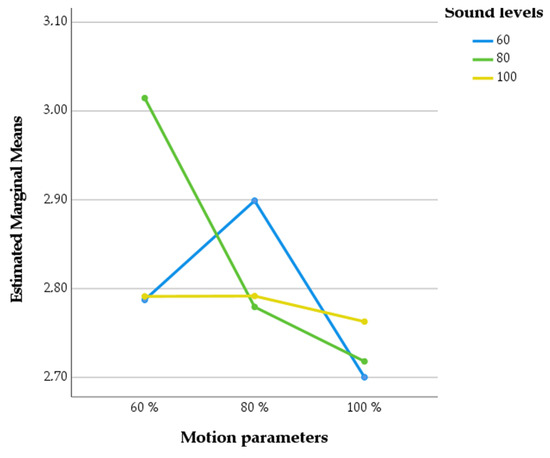
Figure 9.
Effect of interaction between speed and sound levels on assembly time.
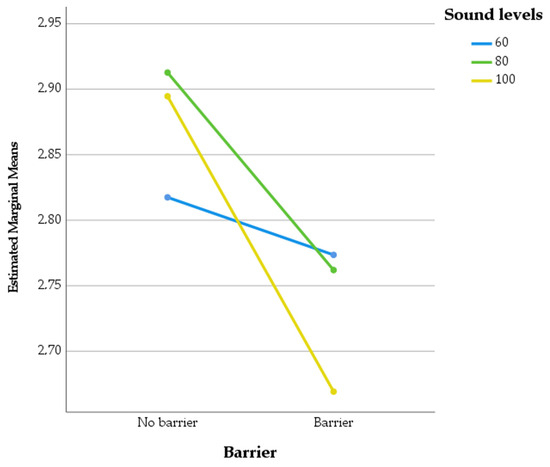
Figure 10.
Effect of interaction between the use of a barrier and sound levels on the assembly time.
Figure 10 shows that, when no barrier was present, the lowest mean assembly time was when the sound was set to the lowest level. While there was no barrier, the participants achieved a mean assembly time of 2.86 s, but when a barrier was introduced, this mean decreased to 2.74 s, showing a 4.4% increase in the efficiency of the CW. However, the results of the RM ANOVA rejected the assumption that this was only due to the introduction of the barrier and instead showed that this could be due to the interaction effect between both the barrier and the sound level of the CR’s motion. If we connect this with Figure 9, it implies that, when participants are not aware of the CR’s movements and believe that the CR has slow movements due to lower sound levels, their assembly times are shorter and efficiency is increased.
Figure 9 and Figure 10 helped us with an answer to the second research question. While it cannot be stated that, when studied by themselves, the sound levels and barrier do have a statistically significant effect on CW efficiency, it can be stated that a statistically significant effect exists between the use of the barrier and the sound levels.
Table 11 presents the summary of research objectives and their achievement, which was assessed with the use of repeated measures ANOVA.

Table 11.
Research goals and their assessment with the repeated measures ANOVA.
To provide an answer to the final research question in terms of which type of scenario (design of CW) was most suitable for the workers, we rely on results from the descriptive statistics. This part of our experiment also included all three factors, with the main focus on whether the CW included a barrier or not. The main goal was to test the worker’s comfort when working with a CR under different conditions, with the focus on the CW in terms of present or absent visual contact barriers. Contrary to our expectations, nine participants preferred the CW without a barrier over the CW with a barrier. Additionally, when we asked the participants which of the scenarios was more comfortable, they provided the answer “Great” more frequently in the scenario without the barrier. For the second scenario with the barrier, the number of responses “Great” decreased, the number of responses “Appropriate” increased, and several responses “Difficult” appeared. From this, we can conclude that the scenario with no barrier was preferable and more suited for the workers. We have also pointed out before that participants achieved on average lower assembly times when the barrier was introduced. It seems that under these conditions, they elevated their performance, but that might add to their discomfort.
5. Conclusions
In this paper, we present how different CR motion parameters affect worker efficiency. The importance is also presented of the sound level and visual impact of the CR on the worker. The results show that a detailed examination of the CW audio-visual effects is the key to an optimal distribution of human-robot production capacities.
The presented experiment design was limited by a laboratory environment and a limited number of participants. The problem studied needs to be extended to the entire production system to fully utilize its potential. The proposed concept offers production companies a broader optimization perspective in their production systems, with the aim of enhancing company efficiency and improving workers’ conditions. Despite the laboratory experiment, the presented work presents the importance of evaluating CWs in a real-world production system. Considering the current state of research, our work represents a state-of-the-art contribution to the research field of CR audio-visual effects on the worker. The importance of the presented work is reflected in the wider perspective that CWs, with their benefits, are increasingly present in real-world environments.
The study provides new and interesting insights into the field of HRC. The impact of individual factors and their combinations is certain, but the presence of these factors and their importance need further investigation. The study provides a basis for further work, as the results only reflect certain findings that cannot be refuted completely. To obtain more authentic results, we intend to expand our experiment in the future with a larger number of participants, study the impact of gender, increase the duration of the experiment, analyze different time measuring periods between working hours, increase the number of iterations, and conduct a real-world application. Regarding the sound level, the measured volume difference in dB was rather small. Therefore, we propose the use of low-, middle-, and high-volume frequency measuring methods to define specifically which frequency of the CR motions affects the worker’s efficiency. Further research is also required to determine what effects sudden changes in motion parameters have on participants and their stress levels, and how this, in turn, affects their performance.
Author Contributions
Conceptualization, R.O. and A.J.; methodology, A.J., K.K. and R.O.; validation, I.P. and R.O.; investigation, A.J. and K.K.; writing—original draft preparation, R.O.; writing—review and editing, R.O.; visualization, A.J., K.K. and R.O.; supervision, I.P. and R.O.; funding acquisition, I.P. All authors have read and agreed to the published version of the manuscript.
Funding
The authors gratefully acknowledge the support of the Slovenian Research Agency (ARRS), Research Core Funding No. P2-0190.
Data Availability Statement
Data sharing is not applicable to this article.
Acknowledgments
The authors acknowledge the use of a research equipment system for development and testing cognitive production approaches in industry 4.0: Collaborative robots with equipment and Sensors, hardware and software for ergonomic analysis of a collaborative workplace, procured within the project “Upgrading national research infrastructures—RIUM”, which was co-financed by the Republic of Slovenia, the Ministry of Education, Science and Sport, and the European Union from the European Regional Development Fund.
Conflicts of Interest
The authors declare no conflict of interest.
References
- Villani, V.; Pini, F.; Leali, F.; Secchi, C. Survey on human–robot collaboration in industrial settings: Safety, intuitive interfaces and applications. Mechatronics 2018, 55, 248–266. [Google Scholar] [CrossRef]
- Lu, Y.; Zheng, H.; Chand, S.; Xia, W.; Liu, Z.; Xu, X.; Wang, L.; Qin, Z.; Bao, J. Outlook on human-centric manufacturing towards Industry 5.0. J. Manuf. Syst. 2022, 62, 612–627. [Google Scholar] [CrossRef]
- Ojstersek, R.; Javernik, A.; Buchmeister, B. The impact of the collaborative workplace on the production system capacity: Simulation modelling vs. real-world application approach. Adv. Prod. Eng. Manag. 2021, 16, 431–442. [Google Scholar] [CrossRef]
- Ojstersek, R.; Javernik, A.; Buchmeister, B. Importance of sustainable collaborative workplaces-simulation modelling approach. Int. J. Simul. Model. 2022, 21, 627–638. [Google Scholar] [CrossRef]
- Rinaldi, M.; Caterino, M.; Fera, M. Sustainability of human-robot cooperative configurations: Findings from a case study. Comput. Ind. Eng. 2023, 182, 109383. [Google Scholar] [CrossRef]
- Casalino, A.; Zanchettin, A.M.; Piroddi, L.; Rocco, P. Optimal scheduling of human-robot collaborative assembly operations with time petri nets. IEEE Trans. Autom. Sci. Eng. 2019, 18, 70–84. [Google Scholar] [CrossRef]
- Gualtieri, L.; Palomba, I.; Merati, F.A.; Rauch, E.; Vidoni, R. Design of human-centered collaborative assembly workstations for the improvement of operators’ physical ergonomics and production efficiency: A case study. Sustainability 2020, 12, 3606. [Google Scholar] [CrossRef]
- Zhang, M.; Li, C.; Shang, Y.; Huang, H.; Zhu, W.; Liu, Y. A task scheduling model integrating micro-breaks for optimisation of job-cycle time in human-robot collaborative assembly cells. Int. J. Prod. Res. 2021, 60, 4766–4777. [Google Scholar] [CrossRef]
- Javernik, A.; Buchmeister, B.; Ojstersek, R. Impact of Cobot parameters on the worker productivity: Optimization challenge. Adv. Prod. Eng. Manag. 2022, 17, 494–504. [Google Scholar] [CrossRef]
- Kliment, M.; Trebuna, P.; Pekarcikova, M.; Straka, M.; Trojan, J.; Duda, R. Production efficiency evaluation and products’ quality improvement using simulation. Int. J. Simul. Model 2020, 19, 470–481. [Google Scholar] [CrossRef]
- De Pace, F.; Manuri, F.; Sanna, A.; Fornaro, C. A systematic review of augmented reality interfaces for collaborative industrial robots. Comput. Ind. Eng. 2020, 149, 106806. [Google Scholar] [CrossRef]
- Al-Haija, Q.A.; Al-Saraireh, J. Asymmetric identification model for human-robot contacts via supervised learning. Symmetry 2022, 14, 591. [Google Scholar] [CrossRef]
- Mak, C.M.; Lui, Y.P. The effect of sound on office productivity. Build. Serv. Eng. Res. Technol. 2011, 33, 339–345. [Google Scholar] [CrossRef]
- Abel, S.M. Combined effects of hearing loss and hearing protection on sound localization: Implications for worker safety. In Scientific Basis of Noise-Induced Hearing Loss; Axelsson, A., Borchgrevink, H., Hamernik, R.P., Hellstrom, P.-A., Henderson, D., Salvi, R.J., Eds.; Thieme: New York, NY, USA, 1996; pp. 286–295. [Google Scholar]
- Story, M.; Webb, P.; Fletcher, S.R.; Tang, G.; Jaksic, C.; Carberry, J. Do speed and proximity affect human-robot collaboration with an industrial robot arm? Int. J. Soc. Robot. 2022, 14, 1087–1102. [Google Scholar] [CrossRef]
- Arai, T.; Kato, R.; Fujita, M. Assessment of operator stress induced by robot collaboration in assembly. CIRP Annals 2010, 59, 5–8. [Google Scholar] [CrossRef]
- Kato, S.; Yamanobe, N.; Venture, G.; Yoshida, E.; Ganesh, G. The where of handovers by humans: Effect of partner characteristics, distance and visual feedback. PLoS ONE 2019, 14, e0217129. [Google Scholar] [CrossRef]
- Tidoni, E.; Gergondet, P.; Fusco, G.; Kheddar, A.; Aglioti, S.M. The role of audio-visual feedback in a thought-based control of a humanoid robot: A BCI study in healthy and spinal cord injured people. IEEE Trans. Neural Syst. Rehabil. Eng. 2017, 25, 772–781. [Google Scholar] [CrossRef] [PubMed]
- Mower, E.; Mataric, M.J.; Narayanan, S. Human perception of audio-visual synthetic character emotion expression in the presence of ambiguous and conflicting information. IEEE Trans Multimedia 2009, 11, 843–855. [Google Scholar] [CrossRef]
- Park, E.; Cho, M.; Ki, C.-S. Correct use of repeated measures analysis of variance. Korean J. Lab. Med. 2009, 29, 1–9. [Google Scholar] [CrossRef] [PubMed]
- Girden, E.R. ANOVA: Repeated Measures; Sage: Thousand Oaks, CA, USA, 1992. [Google Scholar]
- Rutherford, A. ANOVA and ANCOVA: A GLM Approach; John Wiley & Sons: Hoboken, NJ, USA, 2011. [Google Scholar]
- Grimm, L.G.; Yarnold, P.R. Reading and Understanding MORE Multivariate Statistics; American Psychological Association: Washington, DC, USA, 2000. [Google Scholar]
- Field, A. Discovering Statistics Using IBM SPSS Statistics; Sage: Thousand Oaks, CA, USA, 2013. [Google Scholar]
- Shapiro, S.S.; Wilk, M.B. An analysis of variance test for normality (complete samples). Biometrika 1965, 52, 591–611. [Google Scholar] [CrossRef]
- Razali, N.M.; Wah, Y.B. Power comparisons of shapiro-wilk, kolmogorov-smirnov, lilliefors and anderson-darling tests. J. Statist. Model. Analyt. 2011, 2, 21–33. [Google Scholar]
- Mauchly, J.W. Significance test for sphericity of a normal n-variate distribution. Ann. Math. Stat. 1940, 11, 204–209. [Google Scholar] [CrossRef]
- Abdi, H. The greenhouse-geisser correction. Encyclo. Res. Des. 2010, 1, 544–548. [Google Scholar]
- Haverkamp, N.; Beauducel, A. Violation of the sphericity assumption and its effect on type-i error rates in repeated measures ANOVA and multi-level linear models (MLM). Front. Psychol. 2017, 8, 12. [Google Scholar] [CrossRef] [PubMed]
Disclaimer/Publisher’s Note: The statements, opinions and data contained in all publications are solely those of the individual author(s) and contributor(s) and not of MDPI and/or the editor(s). MDPI and/or the editor(s) disclaim responsibility for any injury to people or property resulting from any ideas, methods, instructions or products referred to in the content. |
© 2023 by the authors. Licensee MDPI, Basel, Switzerland. This article is an open access article distributed under the terms and conditions of the Creative Commons Attribution (CC BY) license (https://creativecommons.org/licenses/by/4.0/).